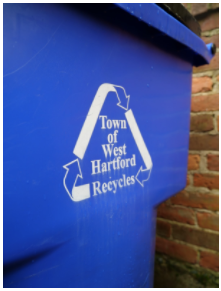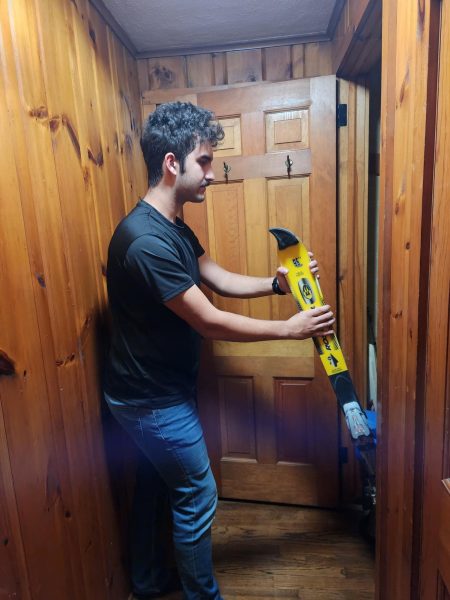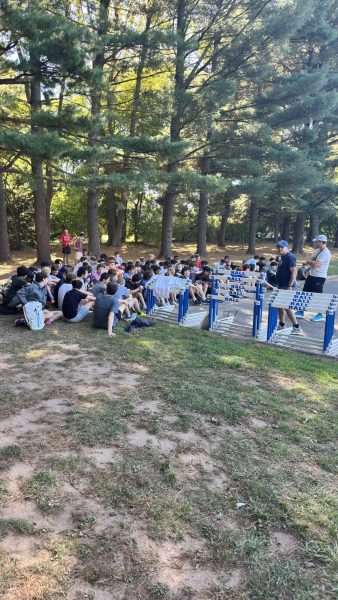School Waste from Utensils, Plates, and Packaging: Is There a Cleaner Option?

Recycling bin in West Hartford.
The effects of pollution from everyday items such as plastic water bottles, straws, and packaging have been projected to the public for many years. As a result, manufacturers and buyers switched to more reusable or recyclable options that have less of an impact on the planet. While progress was made in areas such as the home or in stores, the question still remains as to why school cafeterias have failed to make the switch.
Waste pollution is no secret. According to the Environmental Protection Agency “In 2014 the United States produced 33.25 million tons of plastic, only 9% of which was recycled” and “only 75% of plastics ended up in landfill sites”. As these numbers continue to increase each year, the push towards a solution becomes more prevalent.
At Hall High School, a typical school lunch is served on a styrofoam plate with plastic cups for fruits, vegetables, and side toppings. A plastic reusable tray is placed underneath to carry the food and plastic utensils are used for eating. For sandwiches, wraps, and salads, a plastic container or wrapping covers the food. All of these items except the reusable trays have to go in the trash once used.
“The polystyrene used in traditional lunch trays is a petroleum-based plastic that won’t break down for hundreds of years. When the trays end up in landfills — and 225 million of them do every year — they leech pollutants into the water and air,” says NPR when discussing the current lunch crisis.
The overuse of styrofoam in particular not only concerns the environment but personal health as well. Recent developments by the WHO and the NIH found that styrene, the material that makes styrofoam, is most likely a carcinogen. But these issues do not span as far as we think.
In Japan, school lunch is served on reusable porcelain trays and stainless steel cutlery. The only waste comes from the milk carton and straw, which are then saved and recycled. Other countries around the world also have a similar approach. In Delhi, India, most students bring reusable lunch boxes and only eat at the cafeteria twice a week. The school doesn’t allow polythene bags on campus and there is very minimal waste. If other countries can make changes in their schools, why can’t the U.S? The issue is more complicated than at first glance.
“I struggle because what I’ve learned is that in the world there are no simple solutions,” says Mr. Zittoun, the principal at Hall High School. “If I decide that the environment is the most important part, the solution is using metal and washing them. If economics is my main driver then I have to go back to plastic because it’s a cheaper solution”.
We must consider many factors when deciding the best option for all parties involved. What trade-offs are necessary? What solution is ideal for the long run? What is the priority?
According to Tim Prosinkski, the district food services manager, “Money that we collect from the meals finances the whole department, the uniforms, plastic raps, the vans plus health insurance”. Using more costly, reusable options, would benefit the environment, but what about the staff and students?
A middle school district in Minnesota found that switching to reusable items benefited the school environmentally and financially. Waste and water consumption was reduced, lowering carbon dioxide output. The district is expected to save $23,000 over three years and has “eliminated additional costs associated with storing, unpacking and disposing of the utensils”.
Like the districts in the U.S, the West Hartford district is taking steps toward a more sustainable future. “One school uses reusable trays and we just got approval and 5 of the 16 schools are going to be going to the reusable trays,” says Tim Prosinski. “ We are doing what we can to get away from using the disposable”.
So why hasn’t Hall been approved yet?
The answer: individual student responsibility. “ The only problem I have right now is with the high school because the kids don’t return the trays,” says Tim Prosinski.
If past behavior is any indication of future behavior, highschool students may neglect to return their trays and silverware; A concern voiced by both Mr. Zittoun and Tim Prosinski.
This is why it is important that students take responsibility, and show that they are capable of taking care of reusable items, and therefore, the environment. With the right system in place, implementing reusable trays and silverware could benefit not only the environment but the staff and students as well.
It will take a lot of planning and work to fix the school’s waste issue, but this is a necessary sacrifice. The sooner we spring into action, the faster we can be on track towards a healthier and cleaner future.





